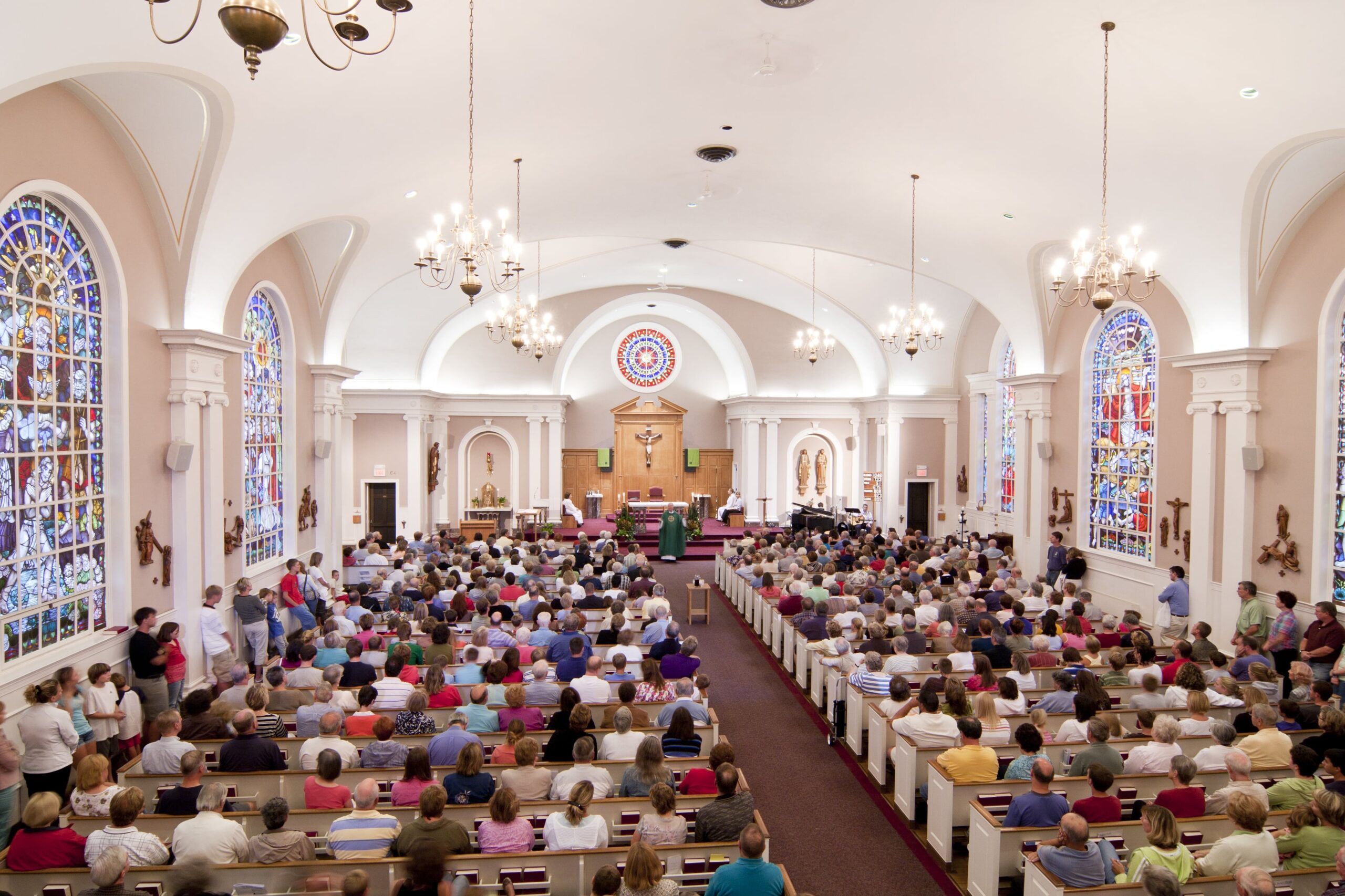The most common question in declining churches is how to grow church participation. I refer to congregational participation rather than church membership. Membership is more important to denominations to measure success and prepare realistic budgets. Participation is more important to congregations, because so long as you come to worship, make regular contributions, and receive the newsletter you’re engaged. They measure success by tracking first and second-time visitors, and adherents are as generous (or even more generous) than members.
This is the key question congregational leaders try to answer: Why do people come to worship? They focus on the Sunday morning experience of hospitality, worship, and education. They discover what seekers seek and adapt their message and music accordingly. Current membership is top-heavy with seniors, boomers, and empty nesters, so their demographic research concentrates on locating families and adapting to their needs.
Church leaders are mystified, however, when it comes to reaching younger, highly mobile, single or co-habituating couples that include Generations Y and Z (millennials and their younger counterparts). This is because they are asking the wrong question. In order to reach these younger generations they must ask…and be prepared to share their answers…to this question: What gives people hope for the future?
As the median age in America rises, and the millennials multiply, the church growth “Generation Gap” widens. Church growth for older generations largely depends on the answer to the first question. But church growth among younger generations large depends on the answer to the second question.
Older generations (including most of the baby boomers that dominate church decision making), connect with a church because they are looking for “love and lessons.” Innumerable church surveys have revealed that the “buzz” around coffee hour before, between, and following worship is mainly about family and friendships or about the sermon and the Sunday school curriculum. Worship generally motivates people to join fellowship groups and couples’ clubs, Sunday schools, and Bible studies.
Younger generations (much in the minority of most churches) connect with a church because they are looking for “hope and heroes.” This is why they rarely go “church shopping” on Sunday morning, and worship is not the primary entry point into the life of the church. They connect through social service and mentoring relationships. The coffee-time “buzz” they seek is not about family and sermons, but about mission and role models.
MissionInsite uses data from the Strauss & Howe Model that identifies leadership expectations. Baby boomers generally gravitate toward “prophets,” which is why they tend to listen more attentively to expository sermons and find inspiration in historical figures. Millennials generally gravitate toward “heroes,” which is why they tend to listen to podcasts and music and find inspiration in larger-than-life superheroes.
Older generations go to the coffee hour. Younger generations go to the coffee shop. It is at the coffee shop that the conversation is more likely about social change and social service. It is at the coffee shop that they are more likely to meet role models for purposeful living. The coffee shop conversations motivate them to volunteer for community service and bond with lifelong mentors.
Do you see the difference? “Love and Lessons”…“Hope and Heroes.” Emphasis on worship, hospitality, and education…emphasis on social service, intimacy, and mentoring. The one grows the church among older generations. The other grows the church among younger generations.
Of course, you and I know that these are huge generalizations; life and society are much more complicated than that.
Nevertheless, the more churches obsess over worship styles, post-worship refreshments, fellowship dinners, and study groups, the older the congregation will become. The more we concentrate on outreach, service, intimate small groups, and mentoring relationships the younger the congregation will become.
As time passes, the success of churches adapting to reach the “family” demographic is diminishing. For these are not the family units that seniors and boomers remember. These are Gen X and Y households seeking answers to an entirely different question.
I grew up in the church, was called into professional ministry, and eventually went to seminary (Princeton Seminary, in fact). There, I was taught the essential connection between grace and gratitude. First, we experience God’s grace for acceptance, forgiveness, healing, guidance, and so on. Then, in response to grace, we show our gratitude through financial giving and community service. Traditional worship is designed with just that flow in mind.
Today there is a different vital connection to be made for all those people who never grew up in a church or who have been alienated by the church. We do not start with grace and move to gratitude. Instead, we start with service and move to spirituality. The spiritual journey today starts in the community rather than the sanctuary, and it ends with a pilgrim walk with Jesus Christ and not just church membership.
God’s Realm expands in both ways – from grace to gratitude, but also from service to spirituality. And today’s church must learn how to empower both ways. Most churches are pretty good at “love and lessons.” That grew the church in the 1990’s. We are not as good at “hope and heroes.” That is what will grow the church in 2020 and beyond.
So ask yourself: how can we refocus outreach away from mere fundraising and sharing space with outside agencies, and toward daily hands-on volunteerism by the majority of participants? How can we refocus evangelism away from committees and charitable donations, in order to multiply heroes of faith and equip individual laity to mentor the next generation?
What gives you hope for the future? The future of the church depends on how you answer that question – and how you share your answer.
I welcome all questions about using MissionInsite for ministry planning and leadership development.
You can reach me at tbandy@acst.com.
Read More:
Tips to Fill the Void for College-Town Churches





Hi, can we share snippets of this article in our weekly bulletin?
Hi Donna! Yes, you are free to share this article in your bulletin. We just ask that you note on the bulletin that the content originally appeared here or credit ACS Technologies. If you have any additional questions, please let us know.
Has this perspective been integrated into the Missioninsite structure?
The Strauss and Howe model is found in the ExecutiveInsite Report. Look for the “Pre-defined reports” list under the Demographics tab. I identify spiritual leadership expectations for each lifestyle segment in the MissionImpact Mosaic Application Guide. Look for this commentary listing all 71 lifestyle segments and 19 lifestyle groups with hyperlinks to ministry expectations. This is under the Help tab.
Thanks for the insight. I liked the love and lessons vs hope and heroes. A real eye opener.
A major challenge to the church today is that many of the decision-makers (board, team leaders, trustees, etc.) are aging baby boomers who are broadly committed to traditional liberal arts education and convinced that “they shall know us by our love, by our love…”. Emerging Busters, Millennials and more have not experienced liberal arts educations and grew up in more narrowly defined professional education tracks (business, applied science, trades, etc.) These generations are more comfortable with dynamic action/reflection learning modules than traditional lesson plans. Moreover, emerging generation already tend to have ways and means to develop intimate relationships; and are hyper-alert to hypocrisy when it comes to declarations of love and real life actions. They have also inherited from boomers a very fractured chaotic world. In a sense, they know how to love, but need a good reason not to despair.
“They connect through social service and mentoring relationships. The coffee-time “buzz” they seek is not about family and sermons, but about mission and role models. ”
Am I correct in taking this as, the more opportunities that the church has for participating in mission and outreach activities, the “younger” the congregation will be?
In general, that’s right. But I am very cautious about generalizations regarding age (as well as other demographic markers like gender, race, occupation, etc.) Today planning depends on more complex lifestyle research. Sooo … younger generations are more likely to connect with a church through outreach on the east, west, and gulf coasts and major metro areas. However, younger lifestyle segments in more small town, rural, or midwest areas will also connect with a particular “Sunday Morning Experience” of hospitality/worship/Sunday school.
For example, consider Lifestyle Group M “Families in Motion”. M45 “Diapers and Debit Cards” gravitating to more urban areas to access education, health, and social services are more likely to connect with a church via outreach (where they are often welcomed and respected) rather than worship (where they sense disapproval). Meanwhile M44 “Red White and Bluegrass” may still connect easily with worship (that is more inspirational and culturally homogeneous) but are often “too busy” to connect with outreach (unless it involves acute disaster intervention). So the general rule is sound, I think, but you have to consider the contextual nuances. These days the buzz word for that is “Contextual Intelligence”.